Sierra Nature Notes, Volume 4, May 2004
Restoring
the Giant Sequoias at Giant Forest, Sequoia National Park
Athena Demetry
Restoration Ecologist
Sequoia and Kings Canyon National Parks
Part II: The Restoration Process
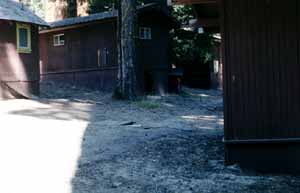 |
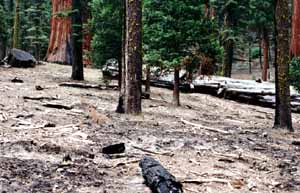 |
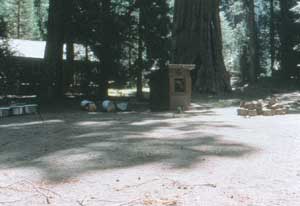 |
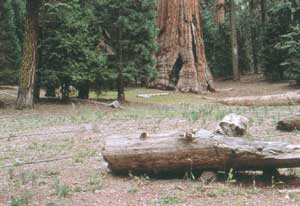 |
| Sequoia
groves, once cluttered with cabins, are now on the way to reestablishing
their former ecosystem. © NPS photos by Athena Demetry. |
|
Removing the
old
The first challenge
of restoring Giant Forest was to demolish and remove infrastructure without
causing further damage to vegetation and soils. To achieve this goal economically
and within the targeted time frame, the demolition was accomplished by
contractors using heavy equipment such as excavators, loaders, and backhoes,
or smaller equipment or hand tools in sensitive areas. As of December 2000,
282 buildings, 24 acres of asphalt, dozens of manholes, a sewage treatment
plant and spray field, and all exposed sewer and water pipe, aerial telephone
and electric lines, and underground propane and fuel tanks have been removed.
Ecological restoration has begun on 231 acres. See our before
& after photo collection of progress as of December,
2000.
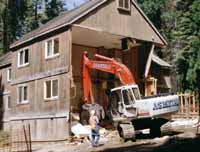 |
| Upper Kaweah guest
lodging is carefully removed during the restoration efforts of 1999. © NPS photo by Athena Demetry. |
The demolition was phased over five major projects, spanning 1997 to 2002. Phase 1 (1997-1999) removed all buildings and infrastructure from the Giant Forest Lodge, and buildings in Pinewood, Highlands, and Firwood. Phase 2 (1999) removed all buildings and infrastructure from Lower Kaweah, Upper Kaweah, and the Market area. Phase 3 (2000) removed the asphalt roads and remaining infrastructure from the Sugar Pine, Sunset, Paradise, Highlands, and Firwood campgrounds, which were abandoned in the 1960s. Phase 4 (2001-2002) will remove the Sherman Tree entrance road and parking lot and replace them with a parking lot outside of the sequoia grove and a trail leading to the tree. Phase 5 (2002) will remove roads in the Bear Hill and Hazelwood areas and the final parking lot in the Lodge area.
Ecological Restoration
After a century of human use and development, the forest ecosystem in Giant
Forest had changed in several ways. Paved roads, trails, and parking lots
changed drainage patterns, allowing water to concentrate and create erosion
gullies. Vehicle and foot travel compacted the soil and quickly broke down
needles and twigs on the soil surface, depleting the topsoil of organic
matter. Groups of mature trees were cleared for buildings and parking lots.
Fire, on which giant sequoias depend for regeneration, could not be used
in Giant Forest Village. There were very few grasses, wildflowers, shrubs,
or tree seedlings in the Village because of lack of fire and human trampling.
Ecological restoration is the process of assisting the recovery and management of ecological integrity. In Giant Forest, the goals of ecological restoration were to:
Restoring Landforms
and Soils
Landforms in Giant Forest had been altered by creating level pads for buildings
and parking lots and by cutting into slopes to create a bench for roads. Road
construction uses a "cut and fill" procedure where soil from the
up- slope side of a road is cut, then pushed to the down-slope side as fill.
To reestablish natural contours and drainage patterns, this road construction
process was reversed: the fill material on the down-slope side of the road
was excavated and placed against the cut slope. The original topsoil could
usually be recognized at the bottom of the fill slope and was placed as the
top layer of the finished surface.
In some cases there was not enough soil on site to restore the original topography. Because soils brought from other locations may have different physical and chemical properties, may not support growth of the same vegetative community, and may contain seeds of species or genotypes that don't belong in Giant Forest, the use of import fill was minimized. Import fill was used only where necessary to restore natural drainage patterns. In such cases, fill was used in deep layers only, reserving local soil for the surface layer.
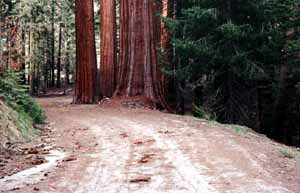 |
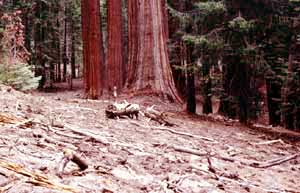 |
| A roadbed on the former Round Meadow loop road is
restored to its original grade and soil type. © NPS photos by Athena Demetry. |
|
Soil properties
were restored to approximate those of surrounding, undisturbed soils. The
most severely altered soil properties
were compaction, alteration
of aggregate structures, and loss of organic matter. To decompact soils and
convert platy and blocky aggregate structures to natural crumb or granular
structures, moist soils were cultivated to a depth of 5 to 8 inches with
small, agricultural-type equipment. Cultivation was conducted outside
the drip lines
of mature trees and was halted or made shallower if major roots were encountered.
To restore organic matter in the topsoil, highly decomposed forest bark humus
was added during cultivation in some locations. Contractors conducted soil
tests to determine application depth of humus necessary to raise organic
matter content to 7 to 10 percent by weight. Because a major influx of
carbon in organic
matter can cause soil microorganisms to proliferate and sequester the soil’s
limited nitrogen for their own use, nitrogen fertilizer was added during
cultivation if soil tests indicated that this was necessary.
Loosened soils were protected with wood chip mulch, soil retention blanket,
or native litter and duff, which was salvaged prior to demolition if present
or was collected from surrounding areas for restoration of linear features
such as roads and trails.
During human occupancy of Giant Forest, erosion gullies had developed where roads, trails, and parking lots concentrated runoff from rain storms or snow melt. In most sites, the removal of the hardened asphalt surface and restoration of the landform was sufficient to correct the erosion problem. In sites where the erosion gully would continue to receive concentrated drainage, rock check dams were installed to slow the flow of water and reduce its ability to erode the soil.
Restoring Vegetation
After the soil was restored, the next phase was to replant.
Development in Giant Forest had altered the vegetation in several ways.
Trees were cleared
for buildings
and parking
lots, leaving
distinct
openings in the forest canopy. The forest overstory was thinner because
trees that threatened human safety and property were removed. Trampling
and soil compaction reduced or eliminated the forest understory, including
grasses, wildflowers, shrubs, and tree seedlings. The soil seed bank, which
influences the regenerative potential of the forest, was likely depleted.
Small patches of wetland vegetation were lost where fill was placed over
meadow edges or streams.
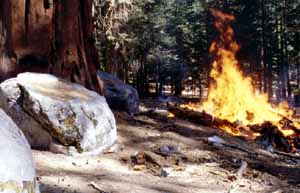 |
| Burn piles were
placed near mature sequoias to produce heat. The intent was to mimic
natural conditions in which heat rises to the canopy, opens
the green cones and causes a seed release. © NPS photo by Athena Demetry. |
To restore the vegetation, ecologists looked to nature for a disturbance condition
that resembled the disturbance caused by human development. In Giant Forest
Village, the forest structure was a matrix of mature canopy interspersed with
openings, or gaps, where patches of trees were cleared for buildings and parking
lots. This condition was similar to surrounding areas of Giant Forest where
natural, prescribed fire had killed patches of mature trees, creating openings,
or gaps, in the canopy. These fire-caused gaps were colonized by patches of
abundant shrub and tree regeneration, particularly giant sequoia, with little
regeneration beneath intact canopy. Because gaps caused by fire are of similar
size to gaps caused by human development, the vegetation growing within them
can be used as a model, or reference condition, for restoration treatments.
For treatments involving planting, mimicking the effects of fire is a particularly
appropriate model because planting methods --within gaps only, during a short
time period, with one to two year-old seedlings -- are similar to the pulse
of regeneration occurring within gaps shortly after fire.
Shrub and tree regeneration in fire-caused gaps was mapped with a total
station. These patterns of regeneration were used as a model for restoring
vegetation
in Giant Forest Village. © NPS photo by Athena Demetry.
This reference condition was quantified in 1994 by mapping and measuring
woody vegetation in 18 fire-caused gaps in Giant Forest, 7 to 15
years following
fire. Gap size was found to account for a significant amount of variability
in density, growth rate, and/or cover of pioneer-type tree and shrub species.
To summarize, the short-term goal of vegetation restoration in Giant Forest Village is to reproduce the species composition, density, and spatial pattern of regeneration that would result from a natural fire event. The long-term goal is to integrate the site into the natural fire regime typical of surrounding areas of Giant Forest. In other words, the Park is putting in place a structure known to be within the range of natural variability, then allowing natural processes to thin the vegetation. By ensuring a vegetation structure similar to surrounding sites after one fire, the Park maximizes the success of this integration.
Active Restoration or Natural Regeneration?
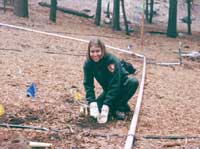 |
| Trees,
shrubs, and herbaceous vegetation are planted within forest gaps where
buildings and parking lots once stood. © NPS photo. |
Because of the duration and severity of changes in developed areas, Park scientists believed that some degree of human intervention was necessary for the recovery of soils and vegetation in Giant Forest Village. Evidence for this view lies in some formerly developed areas within the grove that were abandoned over 30 years ago and show little natural recovery. However, it was also hypothesized that an acceptable restoration of vegetation might be achieved through less intensive and intrusive means than the seed collection, propagation, planting, seeding, and irrigation process traditionally practiced in the Park’s frontcountry revegetation projects. To address this possibility, an adaptive management approach was taken. The goal of adaptive management was to apply different degrees of active restoration in an experimental manner to determine the minimal intervention necessary to meet the reference condition: natural vegetation in fire-caused gaps.
Three levels of vegetation restoration in Giant Forest Village are being tested, in order of increasing human intervention:
1. Restore Soil Only. Actions are limited to regrading to restore natural landforms, amending soils in highly disturbed sites, cultivating, and mulching with litter and duff or wood chips. This is considered the minimal treatment. It was used in four experimental gaps in highly disturbed sites, and also in non-gap areas, former campgrounds abandoned for 30 years or more, and in narrow linear road corridor and trail disturbances through established forest, covering about 42 acres.
2. Restore Soil and Burn. In addition to actions from treatment (1.), a light fire fuel bed and several large slash piles were imported and burned with the intent of releasing sequoia seed and scarifying the seed bank. This treatment was used in four experimental gaps in highly disturbed sites, covering 2 acres.
3. Restore Soil and Plant. In addition to actions from treatment (1.), active planting occurred. Trees, shrubs, grasses, and wildflowers were propagated from local stock (seed and cuttings collected within Giant Forest) to preserve genetic integrity, and planted in gaps using prescriptions formed from fire-caused reference gaps. Gaps are irrigated for 2 to 3 years to enhance survival. Trees (5 species) were propagated by the USDA-Forest Service in Placerville, California, and planted as 1 or 2 year bare-root or 1-gallon containerized stock. Shrubs (12 species) were propagated by Bitterroot Restoration, Inc. in Corvallis, Montana, and planted as 10 cubic-inch or 1-gallon containerized stock. Grasses and wildflowers (10 species) were propagated by the Natural Resources Conservation Service in Meeker, Colorado, and seeded or planted as plugs. Because this treatment was considered to have the highest probability of success, it was used in the majority of gaps in highly disturbed sites, covering 27 acres.
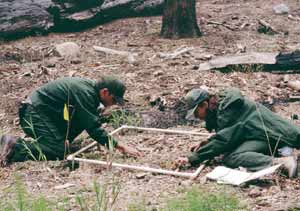 |
| NPS Natural
Resources Personnel quantify vegetation in a gap restored with a burn
treatment. © NPS photo by Athena Demetry. |
As of December 2001, a total of 7275 trees, 4500 shrubs, and 5395 grasses and wildflowers have been planted, and 22 pounds of seed have been sown. Planting has restored nineteen acres of the eventual project total of 27.
The vegetation resulting from these three treatments is being monitored to compare treatment success. First-year monitoring results comparing treatments 2 (burn) and 3 (plant) suggest that both treatments will be successful in producing similar numbers of trees and shrubs as the fire-caused reference gaps 10 years after fire. However, the planting treatment has accelerated the recovery process, with planted gaps having significantly higher plant cover area (that is, the plant canopies are larger) and taller tree seedlings than burned gaps.
Seventy
years after Superintendent White argued for a more pristine Giant Forest,
we are at last realizing his dream. Today’s
restored Giant Forest results from the efforts of many dedicated personnel,
from biologists to heavy equipment operators and the basic grunt work
of shovels. The monumental accomplishments of this project
stem from the unwavering ideals
of managers
and planners
beginning with Colonel White. The
reward of all this effort is to once more walk among these ancient and
silent Sequoias as they had existed for the 2000 yers before we arrived to
disturb their quiet contemplation.
This article first appeared in a slightly different form on the Sequoia
and Kings Canyon National Park web site.
Further Reading
Technical paper (231 KB, PDF format) about the use of fire-caused gaps as a natural disturbance model for restoration.
Species list (171 KB, PDF format) of plants used in the restoration.
Technical paper (1,131 KB, PDF format) discussing monitoring in detail, including a table of survival rates of planted stock.
Our Founder Questions? Go to About Our New Site |
Masthead
Photo from: |